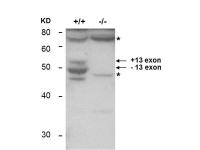BIN1 Mouse Monoclonal Antibody [Clone ID: 2F11]
Other products for "BIN1"
Specifications
| Product Data | |
| Clone Name | 2F11 |
| Applications | IHC, WB |
| Recommended Dilution | ELISA: 1:5000-1:50000, WB: 1:500-1:1500, IHC: 1:100-1:500, IP: 10-100 uL |
| Reactivities | Human, Mouse |
| Host | Mouse |
| Clonality | Monoclonal |
| Immunogen | Anti-BIN1 (MOUSE) Monoclonal Antibody was produced in mouse by repeated immunizations with chimeric protein that encoded the human BIN1 BAR domain followed by hybridoma development. |
| Formulation | 0.02 M Potassium Phosphate, 0.15 M Sodium Chloride, pH 7.2 |
| Concentration | lot specific |
| Conjugation | Unconjugated |
| Storage | Store at -20°C as received. |
| Stability | Stable for 12 months from date of receipt. |
| Gene Name | bridging integrator 1 |
| Database Link | |
| Synonyms | AMPH2; AMPHL; SH3P9 |
| Note | Bin1 is a conserved member of the BAR family of genes that have been implicated in diverse cellular processes including endocytosis, actin organization, programmed cell death, stress responses, and transcriptional control. The first mammalian BAR protein to be discovered, Amphiphysin I (AmphI), was identified in an immunoscreen for proteins associated with the plasma membranes of synaptic neurons, functions in the control of clathrin-dependent synaptic vesicle endocytosis. The mammalian Bin1 gene was first identified in a two hybrid screen for polypeptides that bind to the N-terminal Myc box 1 (MB1) portion of the c-Myc oncoprotein. Bin1 is similar to AmphI in overall structure, with an N-terminal BAR domain and a C-terminal SH3 domain. However, the Bin1 gene is more complex than the AmphI gene, encoding at least seven different splice variants that differ widely in subcellular localization, tissue distribution, and ascribed functions. Alternate splicing of the Bin1 gene results in ten transcript variants encoding different isoform. Bin1 is expressed ubiquitously in mammalian cells. Certain splice variants of Bin1 are expressed in the neurons, muscle cells or tumor cells. ) Bin1 may act with cancer suppressor and inhibits malignant cell transformation. Studies in mouse suggest that this gene plays an important role in cardiac muscle development. Bin1 has also been implicated in Alzheimer disease and cardiac disease. Defects in BIN1 are the cause of centronuclear myopathy autosomal recessive; also known as autosomal recessive myotubular myopathy. |
| Reference Data | |
Documents
| Product Manuals |
| FAQs |
{0} Product Review(s)
0 Product Review(s)
Submit review
Be the first one to submit a review
Product Citations
*Delivery time may vary from web posted schedule. Occasional delays may occur due to unforeseen
complexities in the preparation of your product. International customers may expect an additional 1-2 weeks
in shipping.






























































































































































































































































 Germany
Germany
 Japan
Japan
 United Kingdom
United Kingdom
 China
China




